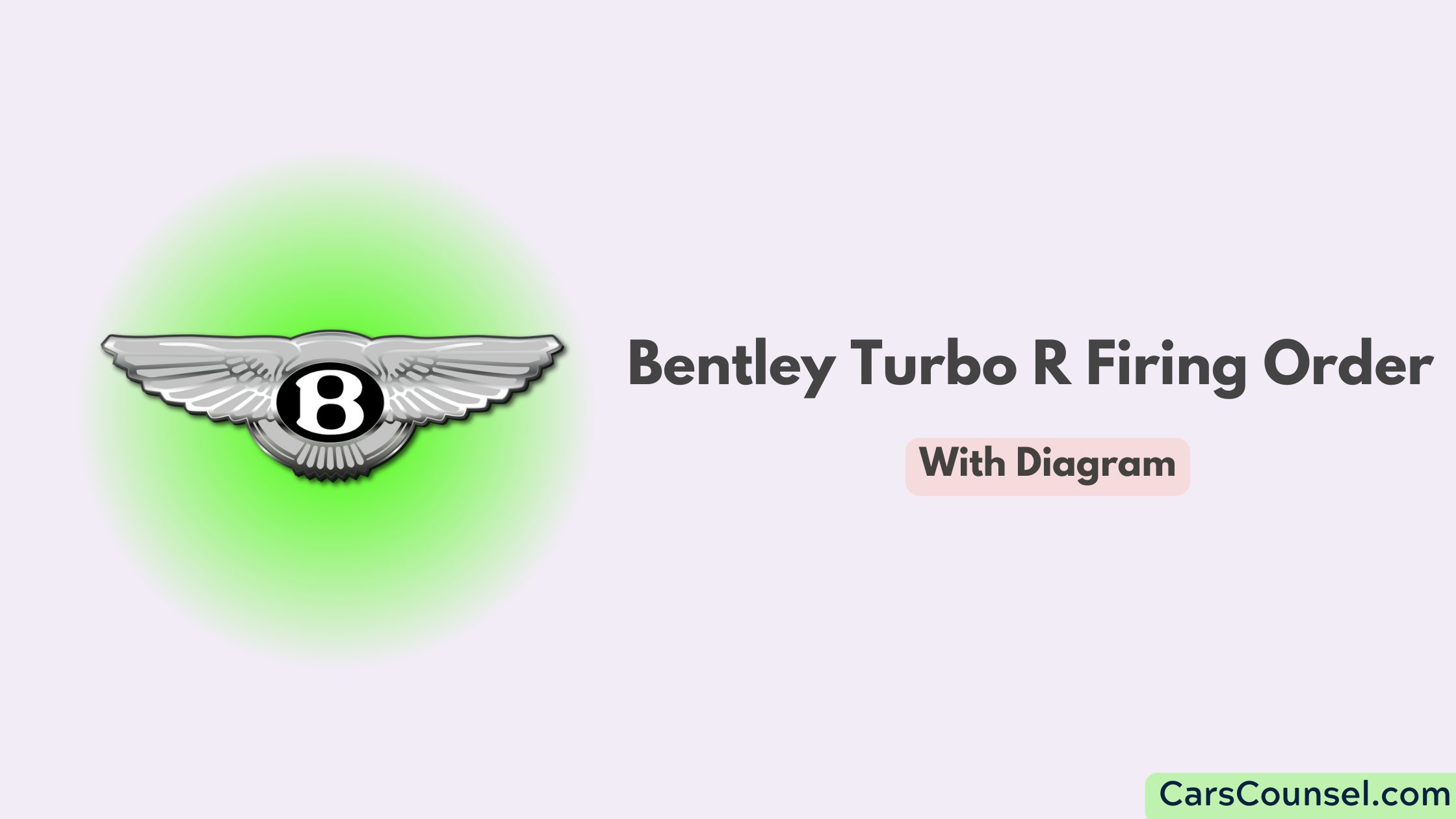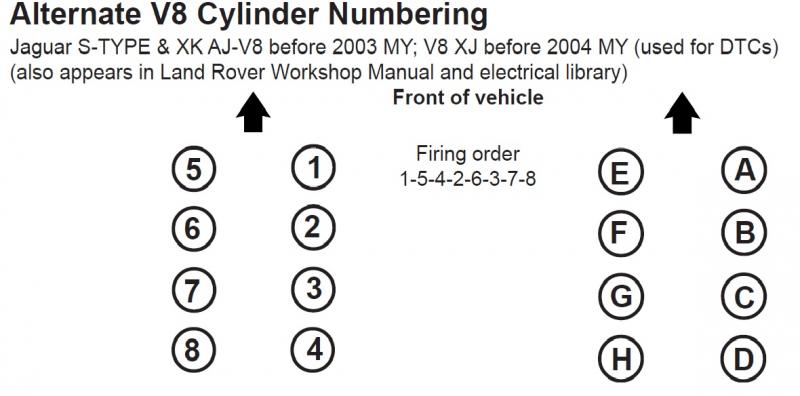The Bentley Turbo R, introduced in 1985, is a symbol of luxury and performance. Equipped with a powerful V8 engine, this vehicle set a new benchmark for Bentley’s engineering excellence. At the core of its smooth operation lies the firing order—the sequence in which its cylinders ignite their air-fuel mixture.
Understanding the firing order is essential for enthusiasts, owners, and mechanics alike. It is also essential for maintaining, troubleshooting, and appreciating this engineering marvel. In this guide, we’ll explore the firing order of the Bentley Turbo R, why it matters, and how to maintain its precision.

Quick Navigation
What is a The Firing Order Bentley Turbo R?
For the Bentley Turbo R’s 6.75L V8 engine, the firing order is 1-5-4-8-6-3-7-2.

The firing order is the sequence in which an engine’s cylinders ignite their air-fuel mixture. This sequence ensures that power strokes are evenly distributed across the engine’s operation, driving the pistons and rotating the crankshaft efficiently.
Why is the Firing Order Important?
The firing order directly impacts the engine’s performance, smoothness, and longevity. Here’s why it’s critical:
Smooth Operation
A balanced firing order minimizes vibrations and ensures the engine operates quietly and smoothly—a hallmark of Bentley’s luxury experience.
Efficient Combustion
The sequence ensures that each cylinder fires at the optimal time, maximizing power output and fuel efficiency.
Balanced Power Delivery
An evenly spaced firing order prevents crankshaft imbalances, ensuring consistent power delivery across all eight cylinders.
Reduced Wear and Tear
Proper timing reduces stress on the engine’s internal components, including the crankshaft, bearings, and connecting rods, prolonging their lifespan.
Understanding the Bentley Turbo R V8 Engine Layout
The Bentley Turbo R is powered by a 6.75L V8 engine, a design that has become synonymous with Bentley’s engineering legacy. To understand the firing order, you must first grasp the engine’s layout.
Cylinder Numbering
The Turbo R’s V8 engine has four cylinders on each side arranged in a “V” configuration.
- Right Bank (Passenger Side): Cylinders 1, 3, 5, 7 (front to rear).
- Left Bank (Driver Side): Cylinders 2, 4, 6, 8 (front to rear).
This numbering system is standard for Bentley’s V8 engines and is essential for correctly identifying the firing sequence.
The Firing Order: 1-5-4-8-6-3-7-2
The firing order of 1-5-4-8-6-3-7-2 dictates the sequence in which the cylinders fire. Here’s how it works:
- Cylinder 1 Fires First: Located at the front of the right bank, cylinder 1 starts the ignition process.
- Cylinder 5 Fires Next: On the left bank, cylinder 5 takes its turn, maintaining balance.
- Cylinder 4 Fires Third: Returning to the left bank, cylinder 4 continues the sequence.
- Cylinder 8 Fires Fourth: The process moves to cylinder 8, at the rear of the left bank.
- Cylinder 6 Fires Fifth: Cylinder 6, also on the left bank, follows.
- Cylinder 3 Fires Sixth: The firing returns to the right bank with cylinder 3.
- Cylinder 7 Fires Seventh: Cylinder 7, at the rear of the right bank, ignites next.
- Cylinder 2 Fires Last: Finally, cylinder 2, on the left bank, completes the cycle before it repeats.
This sequence alternates between banks, maintaining balance and even power delivery.
Components That Execute the Firing Order
Several key components work together to execute the firing order in the Bentley Turbo R. Each must function perfectly to ensure proper engine performance:
Crankshaft
The crankshaft converts the pistons’ linear motion into rotational energy, aligning with the firing sequence.
Camshaft
The camshaft controls the timing of the intake and exhaust valves, ensuring precise combustion.
Distributor
The distributor directs high-voltage electricity from the ignition coil to the spark plugs in the correct firing sequence.
Spark Plugs
Spark plugs ignite the air-fuel mixture in each cylinder, driving the power strokes.
Ignition Wires
These wires connect the distributor to the spark plugs, transmitting electrical current to ensure proper ignition.
Symptoms of Firing Order Issues
When the firing order is incorrect or disrupted, the Bentley Turbo R engine will exhibit noticeable symptoms. Identifying these early can prevent significant damage:
Engine Misfires
Cylinders firing out of sequence disrupt the engine’s rhythm, causing misfires and rough operation.
Rough Idling
An incorrect firing order often leads to uneven idling, with vibrations or stalling at low speeds.
Loss of Power
The engine may struggle to deliver power, affecting acceleration and overall performance.
Knocking or Backfiring
Premature combustion due to incorrect timing can result in knocking sounds or backfires.
Increased Fuel Consumption
A misaligned firing order forces the engine to work harder, reducing fuel efficiency.
Diagnosing and Correcting Firing Order Issues
If you suspect firing order problems in your Bentley Turbo R, follow these steps to diagnose and correct them:
Step 1: Inspect the Distributor Cap
- Check the alignment of the distributor cap with the rotor.
- Look for cracks, corrosion, or other signs of damage.
Step 2: Verify Spark Plug Wires
- Ensure each spark plug wire connects to the correct cylinder based on the 1-5-4-8-6-3-7-2 firing order.
- Replace any damaged or misaligned wires.
Step 3: Use a Timing Light
- Attach a timing light to cylinder 1 and observe the timing marks on the crankshaft pulley.
- Adjust the timing as needed to align with factory specifications.
Step 4: Consult the Manual
- Refer to the Bentley service manual for diagrams and specific instructions related to the ignition system.
Step 5: Test the Engine
- Start the engine and observe its operation. Look for smooth idling, consistent power delivery, and reduced vibrations.
Maintenance Tips to Preserve the Firing Order
To keep the Bentley Turbo R’s firing order functioning correctly, regular maintenance is essential. Follow these tips:
Replace Spark Plugs Regularly
Worn or fouled spark plugs can disrupt the ignition process. Replace them at recommended intervals.
Inspect Ignition Wires
Check for cracks, corrosion, or loose connections. Replace damaged wires promptly.
Service the Distributor
Clean and inspect the distributor cap and rotor. Replace them if they show signs of wear.
Verify Engine Timing
Use a timing light periodically to ensure the engine’s timing aligns with the firing order.
Maintain the Fuel System
Ensure the fuel injectors and lines are clean to support efficient combustion.
Common Misconceptions About Firing Order
“All V8 Engines Have the Same Firing Order”
While many V8s share similar firing orders, differences exist depending on the engine’s design and manufacturer.
“You Can Adjust the Firing Order for Performance”
Altering the firing order without redesigning the engine can cause severe damage and reduce efficiency.
“Firing Order Doesn’t Affect Longevity”
An incorrect firing order increases stress on engine components, shortening their lifespan.
Engines with Similar Firing Orders
Conclusion
The firing order of the Bentley Turbo R, 1-5-4-8-6-3-7-2, is a critical aspect of its smooth and powerful operation. By understanding this sequence and maintaining the components that support it, you can ensure your engine performs as intended for years to come. Regular maintenance, attention to detail, and timely diagnostics are key to preserving this luxury vehicle’s legendary performance.
With proper care, your Bentley Turbo R will continue to deliver the refined power and smoothness that have made it a classic in automotive history. Whether you’re an enthusiast, owner, or mechanic, mastering the firing order is an essential part of appreciating this remarkable vehicle.

